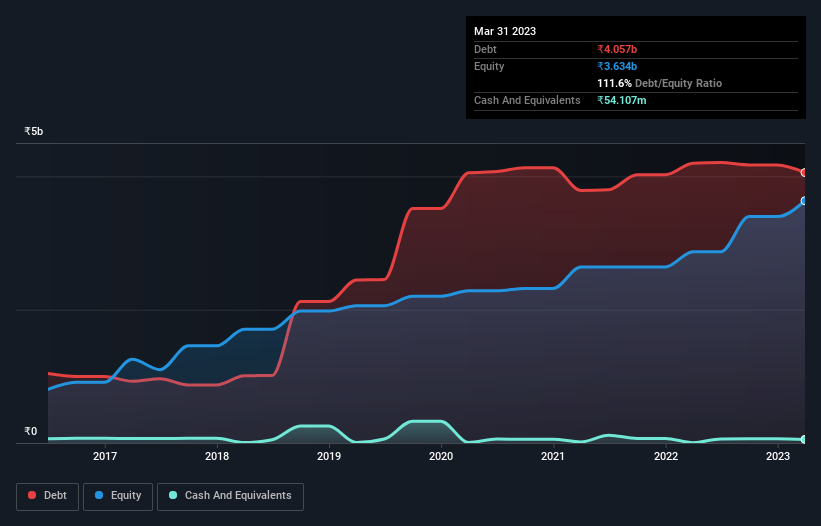Rushil Décor (NSE:RUSHIL) Takes On Some Risk With Its Use Of Debt
Howard Marks put it nicely when he said that, rather than worrying about share price volatility, 'The possibility of permanent loss is the risk I worry about... and every practical investor I know worries about.' So it seems the smart money knows that debt - which is usually involved in bankruptcies - is a very important factor, when you assess how risky a company is. We note that Rushil Décor Limited (NSE:RUSHIL) does have debt on its balance sheet. But the more important question is: how much risk is that debt creating?
When Is Debt A Problem?
Debt and other liabilities become risky for a business when it cannot easily fulfill those obligations, either with free cash flow or by raising capital at an attractive price. If things get really bad, the lenders can take control of the business. However, a more common (but still painful) scenario is that it has to raise new equity capital at a low price, thus permanently diluting shareholders. Of course, debt can be an important tool in businesses, particularly capital heavy businesses. The first step when considering a company's debt levels is to consider its cash and debt together.
Check out our latest analysis for Rushil Décor
How Much Debt Does Rushil Décor Carry?
The chart below, which you can click on for greater detail, shows that Rushil Décor had ₹4.06b in debt in March 2023; about the same as the year before. And it doesn't have much cash, so its net debt is about the same.

How Healthy Is Rushil Décor's Balance Sheet?
According to the last reported balance sheet, Rushil Décor had liabilities of ₹3.00b due within 12 months, and liabilities of ₹3.35b due beyond 12 months. Offsetting this, it had ₹54.1m in cash and ₹1.20b in receivables that were due within 12 months. So it has liabilities totalling ₹5.09b more than its cash and near-term receivables, combined.
This is a mountain of leverage relative to its market capitalization of ₹5.37b. This suggests shareholders would be heavily diluted if the company needed to shore up its balance sheet in a hurry.
In order to size up a company's debt relative to its earnings, we calculate its net debt divided by its earnings before interest, tax, depreciation, and amortization (EBITDA) and its earnings before interest and tax (EBIT) divided by its interest expense (its interest cover). This way, we consider both the absolute quantum of the debt, as well as the interest rates paid on it.
Rushil Décor has a debt to EBITDA ratio of 2.7 and its EBIT covered its interest expense 5.3 times. This suggests that while the debt levels are significant, we'd stop short of calling them problematic. Pleasingly, Rushil Décor is growing its EBIT faster than former Australian PM Bob Hawke downs a yard glass, boasting a 150% gain in the last twelve months. When analysing debt levels, the balance sheet is the obvious place to start. But it is Rushil Décor's earnings that will influence how the balance sheet holds up in the future. So when considering debt, it's definitely worth looking at the earnings trend. Click here for an interactive snapshot.
Finally, while the tax-man may adore accounting profits, lenders only accept cold hard cash. So we always check how much of that EBIT is translated into free cash flow. Over the last three years, Rushil Décor reported free cash flow worth 9.5% of its EBIT, which is really quite low. For us, cash conversion that low sparks a little paranoia about is ability to extinguish debt.
Our View
Neither Rushil Décor's ability to convert EBIT to free cash flow nor its level of total liabilities gave us confidence in its ability to take on more debt. But the good news is it seems to be able to grow its EBIT with ease. Taking the abovementioned factors together we do think Rushil Décor's debt poses some risks to the business. While that debt can boost returns, we think the company has enough leverage now. There's no doubt that we learn most about debt from the balance sheet. However, not all investment risk resides within the balance sheet - far from it. Case in point: We've spotted 3 warning signs for Rushil Décor you should be aware of, and 1 of them shouldn't be ignored.
At the end of the day, it's often better to focus on companies that are free from net debt. You can access our special list of such companies (all with a track record of profit growth). It's free.
New: AI Stock Screener & Alerts
Our new AI Stock Screener scans the market every day to uncover opportunities.
• Dividend Powerhouses (3%+ Yield)
• Undervalued Small Caps with Insider Buying
• High growth Tech and AI Companies
Or build your own from over 50 metrics.
Have feedback on this article? Concerned about the content? Get in touch with us directly. Alternatively, email editorial-team (at) simplywallst.com.
This article by Simply Wall St is general in nature. We provide commentary based on historical data and analyst forecasts only using an unbiased methodology and our articles are not intended to be financial advice. It does not constitute a recommendation to buy or sell any stock, and does not take account of your objectives, or your financial situation. We aim to bring you long-term focused analysis driven by fundamental data. Note that our analysis may not factor in the latest price-sensitive company announcements or qualitative material. Simply Wall St has no position in any stocks mentioned.
About NSEI:RUSHIL
Rushil Décor
Manufactures and sells decorative laminate sheets and medium density fiber boards for use in residential and commercial spaces in India.
Medium-low risk with adequate balance sheet.
Similar Companies
Market Insights
Community Narratives




